| The Saxons slowly migrated into the West Midlands
from the north along the River Trent and its
tributaries. They were colonising the area by the 6th
century. A late seventh century document for tax
assessment called the “Tribal Hidage” lists the dominant
tribes in the area and suggests that the inhabitants
were from the Pencersaetan tribe that took its name from
the River Penk. The early Anglo-Saxon communities lived
in small villages with timber huts thatched with straw,
reeds, or heather. The Venerable Bede, a Priest at the
Monastery of Saints Peter and Paul at Wearmouth and
Jarrow completed his “Ecclesiastical History of the
English People” in 731. It is the primary source of
information on the early English people and the coming
of Christianity. This is what he had to say about the
early immigrants and their territory:
Those who came over were of the three most powerful
nations of Germany - Saxons, Angles, and Jutes. From the
Jutes are descended the people, of Kent, and of the Isle
of Wight, including those in the province of the
West-Saxons who are to this day called Jutes, seated
opposite to the Isle of Wight. From the Saxons, that is,
the country which is now called Old Saxony, came the
East-Saxons, the South-Saxons, and the West Saxons. From
the Angles, that is, the country which is called Angulus,
and which is said, from that time, to have remained
desert to this day, between the provinces of the Jutes
and the Saxons, are descended the East-Angles, the
Midland-Angles, the Mercians, all the race of the
Northumbrians, that is, of those nations that dwell on
the north side of the river Humber, and the other
nations of the Angles. |
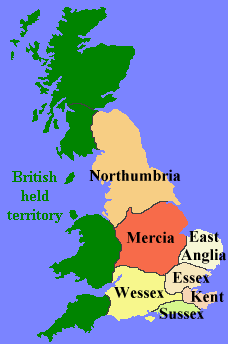
The Anglo-Saxon Kingdoms. Due to
continuous warring the boundaries changed many times. |
Anglo-Saxon England was a turbulent country with a
number of competing kingdoms, always under threat from
European invaders. As the Anglo-Saxons slowly colonised
the country seven kingdoms were established which later
became known as the “Heptarchy”. They were: East Anglia,
Essex, Kent, Mercia, Northumbria, Sussex and Wessex
There were many squabbles between them and the last
three of the kingdoms; Mercia, Northumbria and Wessex
were in a continuous state of war.
Mercia, founded in about 500 A.D. occupied much of
southern England up to the Trent basin. The first
identifiable king was Creoda, who ruled from 586 to 593.
He was succeeded by his son Wybba, who ruled until his
death in 615 and followed by Ceorl and Penda who was one
of the most powerful Mercian kings.
A major influence was the coming of Christianity in the
sixth and seventh centuries. It was brought by Irish
monks to many places such as Iona in 563 and Lindesfarne
in 635. |
|
King Penda who ruled from 632 to
654 was followed by his sons, Peada, Wulfhere and
Ethelred.
Tradition has it that King Wulfhere
founded the Abbey of St. Mary at Wolverhampton (now St.
Peter’s Church) in 659 but there is no proof of this.
The diocese of Lichfield was formed when St. Chad was
appointed as bishop of the Mercians in 669 with a
central church at Lichfield.
Ethelred conquered Kent in 676 and
founded the monastery at Worcester in 679. In 685 Mercia
became the supreme power when Northumbria was invaded by
the Picts. Ethelred retired in 704 to a monastic life,
to be succeeded by his nephew Cenred. His successors
were Ceolred followed by Aethelbald.
King Aethelbald came to power in 716. In his early years
a hermit called Guthlac predicted that he would have
great success in the future and he tried to live up to
this by ruthlessly suppressing several of the smaller
adjacent kingdoms. He attacked Northumbria with little
success but Cynewulf, king of Wessex eventually
acknowledged Aethelbald’s superiority. He had control of
most of the country and almost became the king of the
whole of England. He gave grants to many churches,
created a number of monasteries and gave alms to the
poorer members of society. In 757 he was killed in
battle near Burford, Oxfordshire and his cousin Offa
seized power. |
| Offa is probably the best known Mercian king and was
the first ruler to be called “King of the English”. To
consolidate his position he formed alliances with
Northumbria and Wessex and his daughters were married to
their kings. Like his predecessor he ruthlessly
suppressed any opposition. Between 784 and 786 he built
Offa’s Dyke, a long earthwork running 149 miles along
the western boundary of Mercia to keep out the Welsh. He
introduced the English penny, which was the forerunner
of modern coins. Most of the coins carried his portrait
and some carried the portrait of his wife, Cynethryth.
The coins were probably minted at Canterbury. He formed
links with the Emperor Charlemagne and visited Rome in
792 to strengthen his links with the papacy. |

An Offa penny coin. |
| Offa had a number of royal palaces, his main
residence was at Tamworth. He died in 796. His son
Ecgfrith became king but unfortunately he died a few
months after Offa.
Cenwulf succeeded Ecgfrith and reined until 821. He
died while preparing an assault on Powys and is buried
in Winchcombe
Abbey. He in turn was succeeded by his
brother, Ceolwulf. In 823 Beornwulf forcibly took
control of Mercia but only ruled for two years.
In 789 Offa sent Egbert, the claimant to the Kingdom
of Wessex, into exile in Gaul. After his return in 802
he became King of Wessex and decided to seek revenge by
destroying the supremacy of Mercia. This he duly did and
defeated the Mercian army at the Battle of
Ellandon in 825. He
also seized Kent and Sussex which were
previously parts of Mercia.
After the defeat Mercia invaded East Anglia and King
Beornwulf was killed in battle, to be
succeeded by
Ludecan, who was killed two years later. Wiglaf became
the next to rule, but within a year Egbert took over the
whole of Mercia. |
|
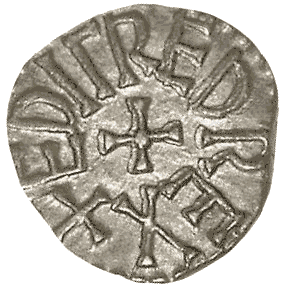
A coin of Ethelred II, King
of Northumbria, 840 to 844. |
In the 800s and 900s
the Vikings attacked the English and French coasts. In
France they were given an area in the north of the
country that became known as Normandy (land of the north
men).
By the end of 828
Egbert ruled the whole of England and from now on rulers
of Mercia would answer to a national king. The first
such ruler appointed by Egbert in 830 was the deposed
Wiglaf, who was in charge until 840. Egbert ruled until
his death in 839 and was succeeded by
his son Ethelwulf who reigned until 856.
In Mercia,
Beorhtwulf succeeded Wiglaf
and ruled until 852, and he in turn was followed by
Burgreda who ruled until 874 when the Danes overran
Mercia. |
| Early Anglo-Saxon kings were military leaders who
were assisted by their lords (thanes). The kings
allotted land to the lords who oversaw their villages.
The villagers were dependant on their lord for food and
labour. The kings were advised by wise men (Witan or
Witenagemot) who formed an assembly of councillors to
advise on administration and judicial matters. The wise
men included bishops and church officials, friends or
relatives of the king and local chieftains. They also
authorised taxes, grants of land and the raising of
armies.
The Kings had a number of Royal Manors throughout the
kingdom and visited them with the royal entourage. This
was a little like a modern Himalayan mountaineering
expedition where everything, including the kitchen sink
is carried by porters. There is a description of this in
J.R. Green's "Conquest of England" which is as follows:
We see the king's forerunners pushing ahead of the
train, arriving in haste at the spot destined for the
next halt, broaching the beer barrels, setting the
board, slaying and cooking the kine, baking the bread;
till the long company come pounding in through the muddy
roads, horsemen and spearmen, theign and noble bishop
and clerk, the string of sumpter horses, the big wagons
with the Royal hoard or the royal wardrobe, and, at
last, the heavy standard borne before the king himself.
Then follows the rough justice-court, the hasty council,
the huge banquet, the fires dying down into the darkness
of the night, till a fresh dawn wakes the forerunners to
seek a fresh encampment.
King
Ethelwulf was succeeded by each of his four sons in turn.
The eldest;
Ethelbald ruled until his death in 860. He married
Judith, daughter of Charles the Bald, king of the
Franks. King Ethelbert followed his brother and ruled
until 866. He in turn was followed by his younger
brother Ethelred, who ruled until 871 and followed by
his youngest brother Alfred, who ruled until 899. |
| King Alfred, known as “Alfred the Great”, was born
in 849 at Wantage in Berkshire. Since the end of the 8th
century the country had been subjected to Viking raids
which began in northern England and eventually spread
along the eastern and southern coasts.
In 865 a vast Viking army landed on the Isle of
Thanet and began a 12 year invasion. By 867 the Vikings
had captured York and soon invaded East Anglia and
Mercia. The only remaining independent Anglo-Saxon
Kingdom, Wessex, was attacked in 870. The Vikings were
initially defeated at the Battle of Ashdown in 871 by
the Wessex army led by Ethelred and his younger brother
Alfred. The Viking onslaughts continued and Alfred came
to power in 871 after Ethelred’s death. The Vikings
led by King Guthrum captured Chippenham in 878 and used
it as a base from which to attack Wessex. Much of the
kingdom was overrun and Alfred and a few of his
followers retreated to the Somerset marshes, which is
where the story of the burned cakes originates from.
Alfred re-grouped and built a fortified base at Athelney
and gathered a mobile army to pursue gorilla tactics
against the invaders. |

The area occupied by the Danes in
the late 800s. |
| In 878 his army defeated the Vikings at the Battle
of Edington and besieged Chippenham until they made
peace. Alfred realised that he could not drive the
Vikings out of the rest of England and so he made an
uneasy peace with them in the Treaty of Wedmore. This
led to the establishment of the Danelaw, which gave the
Danes more or less the eastern half of the country.
Alfred didn’t stop there, he organised an efficient
rapid reaction force to deal with any incursions and
ensured that many of the settlements were well-defended.
He had a royal palace at Winchester and had many fast
ships built for the defence of the coastal areas. He was
patron of the Anglo-Saxon Chronicle, which was copied
and added to in 1154. This is our main source of
Anglo-Saxon history today. He died in 899 and
is buried at Winchester. He is known as “King of the
English” and “Alfred the Great”. Alfred was
followed by his son Edward (known as “Edward the Elder”)
who ruled from 899 to 924.
From 911 until 918 Queen
Aethelflaed
ruled Mercia,
she was followed by Queen Elfwynna who ruled for 12
months. Control then passed to King Edward.
Queen
Aethelflaed became one of the most powerful people in
England. She won many battles against the Vikings and
captured parts of Northumbria and Wales. She
strengthened the defences at Gloucester against the
Vikings and developed the street plan that survives
today. She captured the bones of St. Oswald from the
Danes and gave them to St. Oswald's priory at
Gloucester. She died at Tamworth and was buried in St.
Peter's Church, Gloucester. |
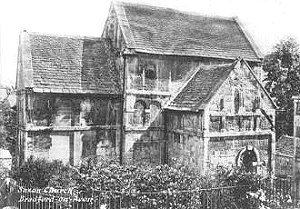
The Saxon church at
Bradford-on-Avon. From an old postcard. |
Edward continued his father’s
military activities and defeated a Viking army near
Tettenhall in 910. In 924 the king of the
Strathclydwallians and the king of the Scots submitted
to Edward, who died later in the year at Farndon. His
son Athelstan then became king.
King Athelstan was an accomplished soldier who
continued to oust the Vikings. In 927-8 he captured
York. In 937 at the Battle of Brunanburh he led the army
that defeated an invasion by the king of Scotland in
alliance with the Welsh and Danes from Dublin. |
| He encouraged people to
move into towns, formed the first shires and
was an avid collector of works of art and
religious relics. These were often given
away to his followers or the church, in
order to gain support. Athelstan died in 939
and was buried at Malmesbury. His
half-brother Edmund succeeded him.
King Edmund continued to suppress the
Danes but only ruled for seven years. He was
murdered during a feast in 946 when he was
only 25 years old. Rule passed to his
brother Edred, who reigned until 955 when
Edmund’s eldest son Edwy became king.
King Edwy was crowned by Oda, Archbishop
of Canterbury in 956 at Kingston-on-Thames.
At the time he was only 13 years old. During
a rebellion Mercia and Northumbria broke
away and Edwy died in 959 at the age of 16.
Edwy was succeeded in 959 by his brother
Edgar, King of Mercia and the Danelaw. Edgar
ruled for 14 years before being crowned at
Bath, along with his queen, Aelfthryth. He
was a good ruler who started a great
monastic revival and introduced universal
coinage and laws throughout the country. He
died on 8th July 975 at the age
of 33 and was buried at Glastonbury Abbey.
His death led to a dispute between the
supporters of his two sons; Edward and
Ethelred. Edward, the eldest son became king
in 975. He was murdered in 979 and replaced
by his 7 year old brother Ethelred.
King Ethelred, known as “The Unready”
ruled from 979 to 1013. He was a poor ruler,
which led to a great deal of unrest and
hostility in the country. He was called "The
Unready" because of his inability to govern.
He was no soldier and the Vikings took
advantage of this with many raiding parties.
The Vikings raided the Welsh coast and
southwest England, they attacked London and
raided the east coast. There were raids from
the armies of Norway and Sweden, but the
main onslaught was from the Danes under King
Swein. Ethelred attempted to buy-off the
Danes using the money levied from the
Danegeld tax. He formed a diplomatic
alliance with the Duke of Normandy and later
married his daughter Emma.
In 1011 the Danish army continued to do
much as it pleased. They even attacked
Canterbury and captured Archbishop Elfeah,
Abbess Leofruna, Bishop Godwin and Abbot
Elfmar. In 1012 the Archbishop was brutally
murdered and King Ethelred handed over
£48,000 from the Danegeld in an attempt to
pacify them. In 1013 Swein became King of
Northumbria and resistance from Wessex
failed. Ethelred was dispossessed by Sweyn
and fled to Normandy. |
|
| The English lords were so disillusioned with King
Ethelred that they eagerly accepted Sweyn as their new
king. Sweyn died in 1014 and Ethelred’s son Edmund took
over the throne. Edmund died in 1016 and Sweyn’s
son Canute became undisputed king. He strengthened his
position by marrying Ethelred’s widow Emma. He also
became king of Denmark and Norway. During his time
abroad England was governed by a group of English and
Danish earls. Canute went on a pilgrimage to Rome in
1027-8 and his Christian humility led to the story of
him demonstrating that even he could not stop the waves.
He died in 1035 and is buried at Winchester. |
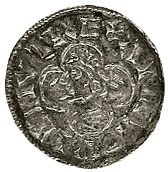
A Canute silver coin |
| Canute had two wives, Elfgifu and Emma. He had a son
by each wife and the two sons became rivals, initially
sharing the country. Harold Harefoot was Canute’s first
son and became King of Mercia and Northumbria.
Hardicanute, the second son was king of Wessex. In 1040
Harold Harefoot died and Hardicanute became king of the
whole of England. Hardicanute’s rule was very short. He
died at Lambeth in 1042 and his half-brother Edward “the
Confessor” became king. |
|
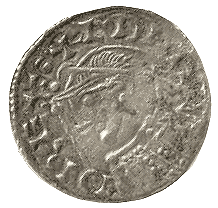
A penny from Edward
the Confessor's reign. |
King Edward was no soldier. He grew up in exile in
Normandy and on his return he was accompanied by a
number of influential Normans. At the time England was
dominated by three earls; Godwin of Wessex, Leofric of
Mercia and Siward of Northumbria. Godwin became the most
important of the three when Edward married his daughter
Edith in 1045. Godwin hoped that the couple would have a
child which of course would be heir to the throne. This
was not to be because Edward had taken a vow of
celibacy.
Edward's Norman sympathies were viewed with suspicion
by Godwin and this came to a head when the king ordered
Godwin to punish the people of Dover after a group
Normans had been involved in a brawl there. |
| Godwin assembled an army
against Edward in 1050 but Leofric and
Siward remained loyal to the king. The army
was defeated and Godwin and his family left
the country and went into exile. In 1051
Edward received his distant relative William
Duke of Normandy as a guest. It is believed
that during the visit Edward named William
as his successor.
After this defeat Edward increased the
number of his Norman advisers, giving some
of them important posts in office. There was
much hostility towards the Norman
appointments and Edward lost the loyalty of
the other Earls. In 1052 Godwin arrived on
the south coast with his sons Harold and
Tostig and a huge army. Edward was unable to
raise an army to oppose them and had to
agree to Godwin's terms.
Godwin was now the most powerful man in
England. He forced Edward to remove his
Norman councillors, but died in 1053 and was
replaced by his son Harold, who became
Edward’s chief advisor. Edward founded a new
abbey at Westminster, dedicated to St.
Peter. He is said to have named Harold as
his successor on his deathbed, even though
he had earlier promised the throne to
William Duke of Normandy. He may have been
manoeuvred into this by the Saxon lords.
Edward died on 5th January 1066
and on the following day Harold was crowned
as the new king in Westminster Abbey.
King Harold would have feared the rival
claims to the throne from William Duke of
Normandy and Harald Hardrada of Norway. In
his earlier years Harold had been captured
in France. Whilst still a prisoner he is
said to have sworn, under duress, that he
would not accept the English throne but
would support Duke William’s claim.
He awaited the expected Norman invasion
but his plans to defend the country were
thrown into disarray when his estranged
brother Tostig, Earl of Northumbria and
Harald Hardrada of Norway led an invading
army from the northeast. Harold, an
outstanding soldier marched northwards with
a large army and ruthlessly defeated the
invading forces. In the meantime William and
his invading army arrived in Sussex and
Harold marched southwards to defend the
country. Harold and his 7,000 strong army
were at a great disadvantage because they
were suffering from the exertions of their
previous battle and the 240 mile long march
to the south. The Anglo-Saxon era ended when
Harold was defeated near Hastings and killed
during the battle. William became the first
Norman king and was crowned in London on
Christmas day 1066.
Anglo-Saxon influence is still all around
us today. Not only did they give us the name
of our country but also the basis of our
language. |
|
 |
Return to
the
previous page |
|